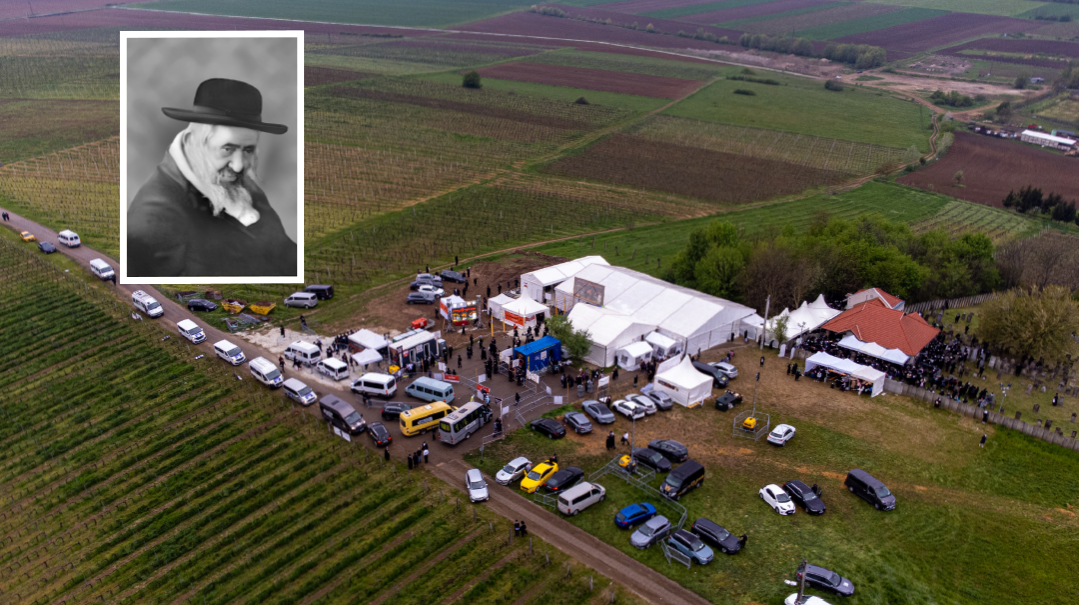High Spirits

Binyamin Terebelo crafts new whiskey tapping age-old tradition
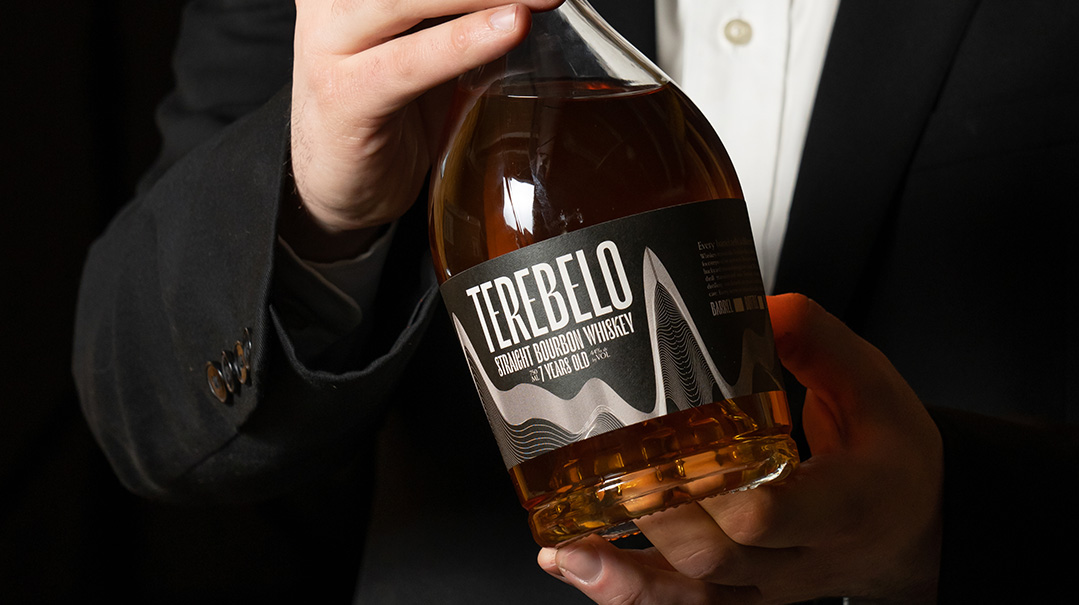
Photos: Yaacov King
It’s a cold, overcast day, with frozen rivers lining the sides of the upstate roads and intermittent downpours interrupting our trip when I make the trek to the newly fermented Terebelo Boutique Distillery in Utica, New York, a five-hour trip from Brooklyn. This is the modern version of Moshke with the mashkeh, only this time it’s a 30-year-old Lakewood kollel yungerman serving Yossel and Yankel, not Ivan and Stepan. And there’s no kretshme.
I can tell the difference between Coke and Pepsi with just a sip, but I’m not a booze guy. But in the spirit of Purim I gamely go ahead, and finally we reach our destination: Utica’s brewery district. There are several other distilleries in the neighborhood, along with five-story buildings that count as “skyscrapers” here. The tenth-most-populous city in the state, Utica today serves as a dismal graveyard for its once-thriving textile industry, a victim of manufacturing’s move to China.
Distilleries are under the jurisdiction of the federal Bureau of Alcohol, Tobacco, Firearms, and Explosives, and are more heavily regulated than stock exchanges. There are guidelines for what material the walls may be made from, what kind of lock is allowed on the door, and an archaic arrangement of where barrels must be placed on the floor once taxes are paid on them. Distillers must own their factories and equipment before even applying for a license.
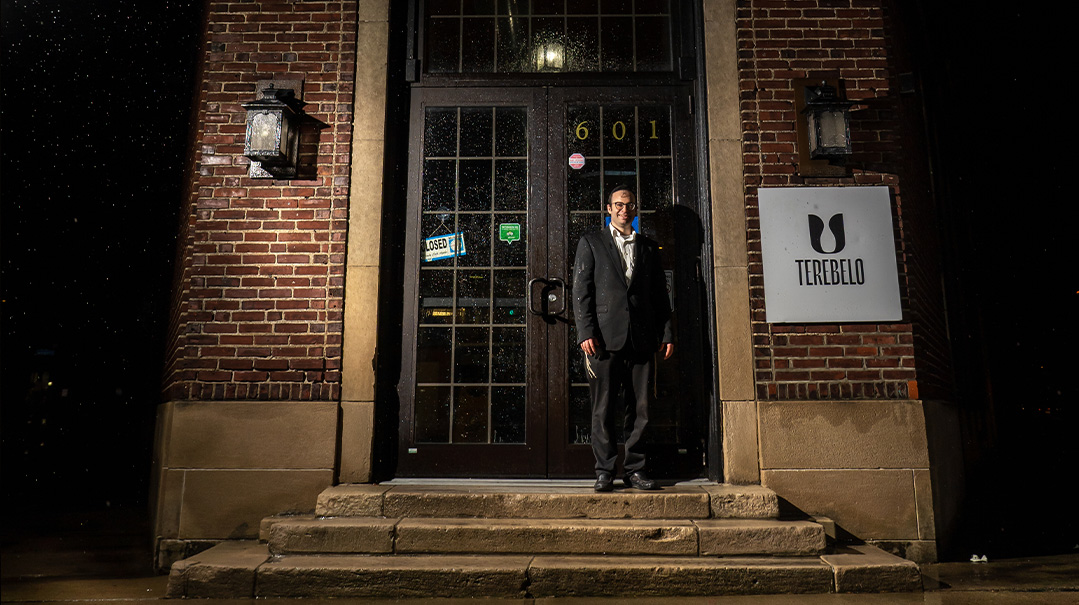
Terebelo Goes Pro
Binyamin Terebelo, always a whiskey aficionado, went pro some five years ago, purchasing the distillery in Utica and garnering a hechsher from the Star-K. He has whiskey in his genes — his great-grandfather, Reb Zelig Dov Terebelo, was a prominent bootlegger in Detroit during the Prohibition era, selling his spirits to fellow Jews. Now his descendant is taking the family business to a new high.
Terebelo, who lives in Passaic with his wife and three children, always enjoyed dabbling in whiskey making, and slowly put away money on the side to open a distillery of his own. His wife, Goldy, an occupational therapist, supported his dream. He finally reached critical mass in 2017, buying the distillery from Jordan Karp. Karp still works there as a hobby, sampling with various products under the Adirondack label and producing a line of hand sanitizer called Hand in Hand.
Despite his profession, Terebelo says he is not much of a drinker.
“I enjoy the science,” he says. “If I know a bourbon was made in a boutique distillery, I can appreciate the work. But when I see one mass produced by some big company, I think it’s awful. It’s like a knockoff painting compared to an original.”
Together with his family, he goes up to Utica for a week or two during the mashing and fermentation process, and about once in two weeks when it comes to the bottling and labeling. Aside from him and Jordan, the distillery employs one other worker.
Distilling alcohol isn’t exactly the typical yeshivah thing to do, but his friends, Terebelo says, “are fascinated by it.”

Moonshine with Yichus
The Terebelo family has been in America for at least six generations. Binyomin Terebelo, Binyamin’s great-great grandfather, took advantage of Prohibition, the 18th amendment to the Constitution prohibiting the sale of alcohol, to set up a home distillery along with his sons Zelig Dov and Meir. The amendment, which passed in 1920, proved disastrous, leading to a thriving black market for liquor, and it was repealed 13 years later.
The Terebelos manufactured an odorless vodka, smuggling it around in baby strollers, figuring the police prowlers wouldn’t lift the blanket and risk waking the “baby.”
“I recall it,” says Yehoshua Terebelo, a son of Zelig Dov and Binyomin’s grandfather, “but I wasn’t an active participant in it. But I don’t want to be known for that. Put me in as a plain poshute Yid.”
Yehoshua, who lives in Detroit, had wanted to come along on the trip to Utica, but health reasons prevented it. “My son Zelig a”h wanted Binyomin to have something to do that brought in parnassah, and at the same time would let him sit and learn,” he says.
Zelig Terebelo, Binyomin’s father, was niftar suddenly about nine months ago.The older Mr. Terebelo remembers his father pushing the buggy as if there was a baby in it, “but it was really bottles of booze.” They had to be extra careful when going over bumps in the road, because the bottles would clink against each other.
To the best of his knowledge, his father was never caught. “They only sold to people they knew. It was a hush-hush business. They would make it as quick as they could and sell it as quick as they could. But the police were probably all drinking.”
The business survived the amendment rescinding Prohibition, though their moonshine didn’t command the same high prices as it did when it was on the black market, and the heimishe speakeasy shut down about three years after whiskey became legal again.
As for the carriage, “it was probably used as a baby carriage again,” Terebelo says with a chuckle. “But it’s gone now.”
Yehoshua is proud to be an early customer of Terebelo Distillery’s whiskey. “It tastes good,” he pronounces.
There you go. A stamp of approval from Zeidy.
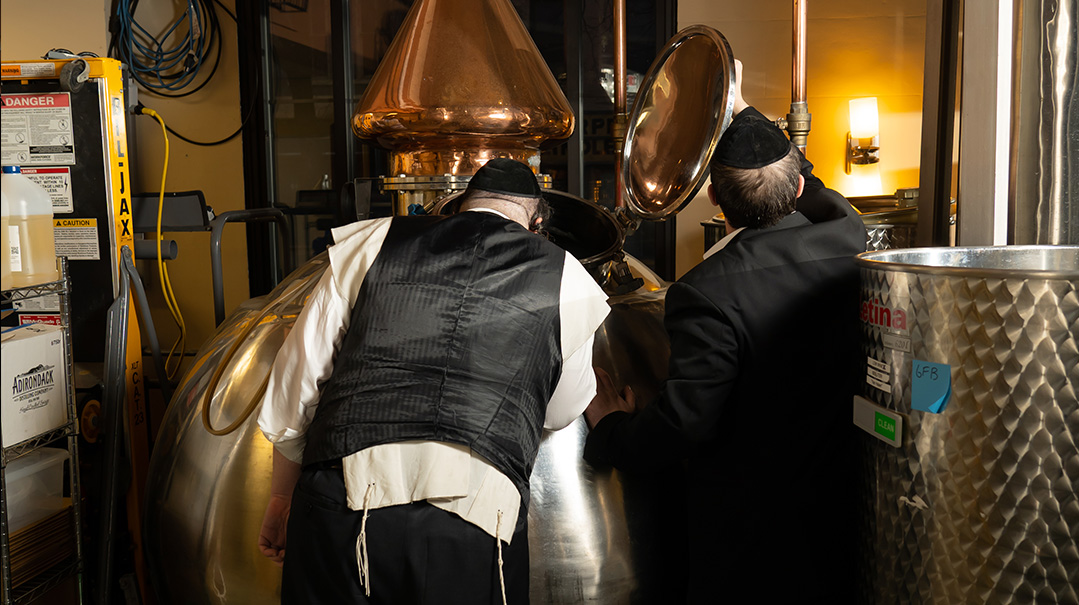
Why Grapes?
Terebelo uses corn for his product, though he explains that basically anything with sugar can be used to make whiskey — just liquify it, add yeast, and allow it to ferment. A photo album prepared by Binyomin’s wife shows the family throwing their brainpower at a variety of foods, from pineapples to potatoes to esrogim, transforming their sugar content into alcohol. Even bread and milk can be used, though the latter is harder to break down. (Goldie and Binyomin’s mishloach manos consists of some chocolates and homemade liquor called “The Golden Bin.” Get it?)
During Prohibition, Terebelo’s grandfather recalled, people would send each other packages of grapes and yeast along with a warning note, a la modern cigarettes sold with the “smoking kills” label, stating: “Do not mix. It’s against the law.”
If anything can be made into liquor, then why did Noach choose grapes?
“I’ve been bothered by the question for a long time,” Terebelo acknowledges. “Why grapes? The simple answer is that it’s the only fruit with the natural combination of fructose and yeast.”
Put simply, grapes are the only fruit that can be cut and placed in barrels, and will then ferment on their own.

Heads and Tails
We begin our tour in the far-right corner of the small, triangle-shaped distillery, where a large metal vat lies partially submerged in the floor. A bucket of wood chips is on top of it, its contents steeped with bourbon — add water and you got booze. Indeed, the Gemara in Avodah Zarah states that the Roman army would hydrate its soldiers by soaking wood chips in wine, drying them, and then distributing them to the military bases.
“Here’s where it starts,” Terebelo says, motioning to the vat. “Except that you don’t see the corn now. We’re up to the bottling stage already.”
The corn gets cooked in these 1,000-gallon vats for three hours until it turns into a frothy liquid. It’s then transferred via large pipes into five massive vats that dominate the room. Yeast is added, and the corn soup seeps and stews in these vats for a week until it turns into mash, with a 7 percent alcohol content.
This would be enough to make wine or beer. But for whiskey, it’s only the beginning of a long process.
“You start off with beer, you never go straight into whiskey,” Terebelo says.
Beer, or mash, is the raw corn or barley mush that could end up as either beer, schnapps, or hand sanitizer. If beer is the final product, then you would mix in hops at this stage and keep the mash at its low alcohol level. But for whiskey production, there’s still the distilling and aging processes, which can take years.
The liquid is pumped into a squat, round vat where it’s distilled into pure alcohol. Alcohol’s boiling point is 173 degrees, while water boils at 212 degrees; so the alcohol begins evaporating through a pipe into a different vat much sooner, allowing it to separate from the water.
Distillery lingo refers to heads, hearts, and tails. The first portion of the evaporated whiskey, about 2 percent, is called heads, or poisoned alcohol. It can be made into rubbing alcohol or hand sanitizer, but it doesn’t pay for Terebelo’s small operation to dabble in that, so he just discards it.
After that, the next 7 percent or so is pumped into the vat to be used for the schnapps. Then the hearts alcohol is removed from the machine and aged in oakwood casks for years. The leftover 90 percent, which is water, is called tails. Larger distilleries sell it for animal feed, but Terebelo tosses it.
Each time alcohol is put through the distilling process, it becomes purer, but each additional round eliminates some of the original flavor.
“If you have a cheaper corn,” Terebelo explains, “you want to distill it more, so you have less of the corn flavor and more of the alcohol. If you have a better corn, then you want to distill it less so you have more of the corn flavor.”
The first run with the Terebelo logo, some 300 bottles clinked out to market three months ago, selling for $139 to $169, mostly in Lakewood stores. He expects an additional 1,000 bottles to go out before Purim, followed by new releases each quarter.

Hitting the Right Note
Continuing our tour, we descend to the basement. It’s fairly cold there, with classical music playing softly.
“Classical music helps the whiskey age,” Terebelo asserts.
This is similar to the Ketores in the Beis Hamikdash, I noted. The Yerushalmi in Yoma says the Ketores mixers would recite the words “well ground, well ground, because the sound is helpful to the spices.”
Terebelo’s grandfather, Yehoshua Terebelo , created a playlist he claims is guaranteed to age whiskey, and Binyomin claims he can tell the difference. “But Jordan says it’s just that I have luck with my corn.”
Some three dozen 30-gallon casks lie on their side along a row of racks. I open one of them, and a sharp scent of bourbon rises up. It has a date of June 6, 2017, making it nearly five years old. Terebelo says he can tell the year by tasting it.
“The older it is, the softer it is,” he says. “It mellows with age.”
He takes a suction and draws some of the golden liquid out, pouring it into a shot cup. He tastes it slowly.
“This needs water,” he rules. “It’s cask strength.”
That means it’s ready for proofing, in which water is added for a softer whiskey.
Another set of racks holds five barrels, one of which was his first barrel, given to him by his late father, and the rest of which are 30 years old. They indeed are noticeably older than the others, with a yellow corn paste sealing it and a quintet of metal fasteners holding it shut.
“These are coming home with me as soon as they are done,” he says. “We turn them into wood chips and make a barbecue out of it.”
A dozen bags, each holding hundreds of tan cork stoppers, lie on a shelf. Off to one side, sit small boxes of unlabeled bottles — six 750-milliliter bottles in some and about 120 100-milliliter bottles in others.
He fills up a bottle with bourbon for an upcoming family simchah, for sentimental reasons taking from the barrel gifted to him by his father. He sniffs it before putting it into a bottle.
“This is 68 percent proof,” he says, raising it in the air. “I’m going to have to add water.”
He will add about a third water for proofing, the final step of the production. Industry norm is a 40 proof, but Terebelo enjoys a little more alcohol content, so he has 44 proof. Bottles are then washed, filled, and then have the Terebelo label added by hand.
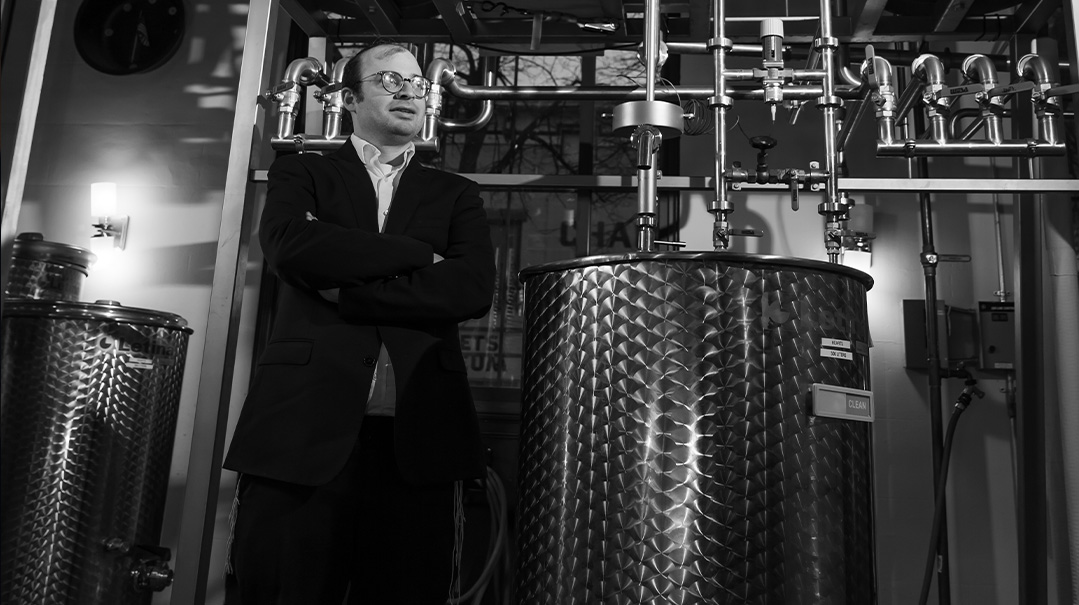
Bringing Utica’s Spirits Back
Utica’s Jewish community last made news in the 1930s, when Rabbi Avraham Shapiro was the rav. A brother of Rav Boruch Shapiro, the Seattle rav who earned a rare semichah from the Rogatchover, Rav Avraham was an energetic participant in the battles to preserve Yiddishkeit in America. He probably would have approved of the kosher bourbon being produced within a mile of his former home.
Utica had a thriving community until it began waning in the 1980s, mirroring the story of upstate New York. Today, a Jew in Utica is as scarce as a frown at a clown festival. Its last kosher bakery had its hechsher yanked a year ago. Nevertheless, it does have a Chabad presence, Rabbi Levi and Frumie Charitonow. Terebelo brought along some fresh Danishes for Rabbi Charitonow. The rabbi, who is originally from Buffalo, came to visit the distillery while we were there, and he insists that “there’s a lot of work to do here.”
But not enough for a daily minyan. All the shuls have merged into one, and it’s only open on Shabbos. Terebelo, who is in the year of aveilus for his father, times his trips to make it back to his home in Passaic for Minchah to say Kaddish, or heads to Albany, a 90-minute drive away.

The Proof Is in the Pudding
You don’t need much knowledge to cook up grain or corn and let it ferment. The difference between the pros and the amateurs are in the nuances.
“Most of the production is pretty simple,” Terebelo explains. “It’s the science behind it that makes the difference. How much sugar content to leave in the corn, which corn to use, which yeast to use, when to turn off the fire, when to take it out of the barrel. If it ages too much, it takes on the taste of the oak barrel.”
The better the corn and the barrel, the quicker the spirits age and are ready for prime time. Terebelo purchases expensive sweet corn that costs an expensive dollar a pound, and Oklahoma oak and gluten free barrels — with a corn-based paste — to seal them.
“I read an article that said that Macallan, which is the Rolls Royce of the Scotch industry, has a very oaky flavor,” he recalls. “That’s not good — you don’t want the oak to overpower the whiskey.”
For Terebelo, the proof is in the pudding (if you’ll forgive the pun). He says that people who enjoy alcohol call his products “silky at the end.”
And while he got into the booze business for parnassah reasons, Terebelo says that watching the process unfold has aided his learning. “I understand the science and the lomdus behind the whiskey the same way I understand the lomdus in my learning,” he says, waxing philosophical. “And when you deal with whiskey, you really appreciate Chazal’s teachings how age mellows and improves and makes things better.”
His distillery is only five years old, but he notes that gin has been in his genes for five generations already. “I’m like aged wine in a new vessel,” he proclaims.
(Originally featured in Mishpacha, Issue 902)
Oops! We could not locate your form.


